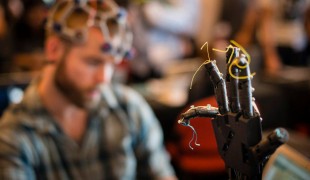- 8940
- 612
- 7
- 11
- 0
- Help Ukraine
About the solution
After launching a successful crowdfunding campaign in 2013, Conor and his co-founders created their own company.
“OpenBCI is a low-cost, programmable, open-source EEG platform that gives anybody with a computer access to their brainwaves. Our vision is to realize the potential of the open-source movement to accelerate innovation in brain science through collaborative hardware and software development. Behind the many lines of code and circuit diagrams, OpenBCI has a growing community of scientists, engineers, designers, makers, and a whole bunch of other people who are interested in furthering our understanding of the brain”, it says on the crowdfuning campaign page.
OpenBIC not only helps patients get their own data, it is also a very useful tool for learning.
“A huge proportion of our customers are students, graduate-level researchers and professors who want to use OpenBCI as a learning tool,” Conor explained.
The package comes with OpenBCI’s “signal capture system” (headset with circuit board) and electrode starter kits, and it costs $300.
More info: http://openbci.com
Adapted from: https://bit.ly/2qYBQtt
This solution shall not include mention to the use of drugs, chemicals or biologicals (including food); invasive devices; offensive, commercial or inherently dangerous content. This solution was not medically validated. Proceed with caution! If you have any doubts, please consult with a health professional.
DISCLAIMER: This story was written by someone who is not the author of the solution, therefore please be advised that, although it was written with the utmost respect for the innovation and the innovator, there can be some incorrect statements. If you find any errors please contact the patient Innovation team via info@patient-innovation.com
-
-
506
-
0
-
7751

Man invents low-cost, high-quality biossensing hardware for brain computer interfacing
COMMUNICATION: Communicating, whether by speaking, listening, or other means
CAREGIVING
Rubgy
Brain Injury (Abscess, Brain Barrier Defect, Brain Contusion, Brain Hemorrhage, Brain Edema)
Cervical spinal cord injury/Tetraplegia
3d Printed
Assistive Technology access
Difficulty coordinating movements
Muscle weakness
Memory loss
Sleep disturbances
Headaches
Managing Neurological Disorders
Preventing (Vaccination, Protection, Falls, Research/Mapping)
Neurology
Sports Medicine
United States
-
-
-
510
-
0
-
8451

Student invents "epilepsy alarm" for his grandmother
CAREGIVING
COMMUNICATION: Communicating, whether by speaking, listening, or other means
Epilepsy
App (Including when connected with wearable)
Muscle cramps or spasms
Stiffness or rigidity (difficulty moving)
Loss of balance
Sleep disturbances
Anxiety
Twitching or involuntary movements (myoclonus)
Seizures
Managing Neurological Disorders
Enhancing Mental Health
To improve Treatment/Therapy
Preventing (Vaccination, Protection, Falls, Research/Mapping)
Caregiving Support
General and Family Medicine
Neurology
Psychiatry
Public Health
China
-
-
-
966
-
0
-
20985

System to track autistic children
CAREGIVING
COMMUNICATION: Communicating, whether by speaking, listening, or other means
Social interaction
Autism
Assistive Daily Life Device (to help ADL)
Body-Worn solutions (Clothing, accessories, shoes, sensors...)
App (Including when connected with wearable)
Anxiety
Difficulty concentrating or making decisions
Social withdrawal or isolation
Restlessness or feeling slowed down
Loss of interest or pleasure in activities (anhedonia)
Promoting self-management
Managing Neurological Disorders
Preventing (Vaccination, Protection, Falls, Research/Mapping)
Caregiving Support
Child and Adolescent Psychiatry
Medical Genetics
Neurology
Pediatrics
Psychiatry
Israel
-
 en
en